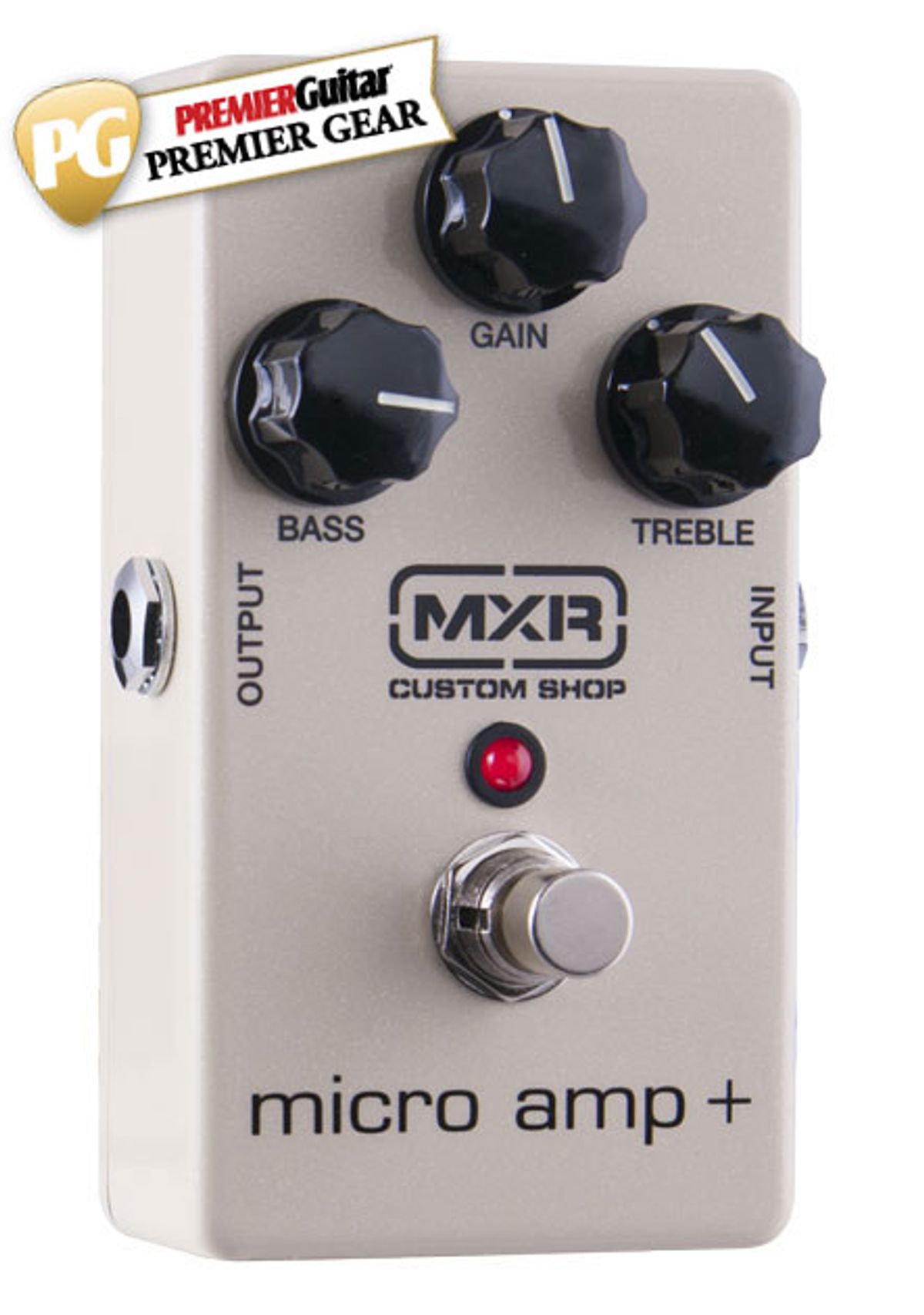
MXR refines an unsung classic and creates a potent tone-sculpting tool.
Despite being a huge seller, MXR’s Micro Amp booster is an under-appreciated little pedal. It’s easy to see how this underrated classic might go overlooked: With a single knob and stark black-on-white graphics, it’s practically the stompbox equivalent of a government-issue Toyota Corolla. But like Toyota’s venerable econobox-that-could, the Micro Amp is a reliable, solid, predictable, and dirt-cheap machine. And it remains the perfect clean boost pedal for certain less-is-more players.
Though some guitarists consider the op-amp-driven Micro Amp indispensible (Jack White for one, rarely uses a pedal board without one), nitpickers find it trebly, noisy, and a little too streamlined. For those doubters and skeptics, the MXR Custom Shop’s new Micro Amp+ may be a revelation. With +26 dB of boost, it’s every bit as potent as the original. It’s quiet. And with the addition of two powerful cut/boost bass and treble controls, it’s exponentially more adaptable to changing backlines and guitars.
Still Stupidly Simple
To its credit, the MXR Custom Shop didn’t do anything fancy to dress up or differentiate the Micro Amp+ from its predecessor. The paint is a subtly pearlescent vanilla rather then the original’s gloss milk white. The interior is appropriately minimalist too—just a 9-volt battery clip and a printed circuit board that’s flipped to keep its components out of harm’s way. The real news is the new bass and treble controls, and how they transform an already great-sounding booster.
Tone Scrubbing with Mr. Clean
Transparency is an overused (and generally inaccurate) way to describe most overdrives and boosts. Even the cleanest boost adds shading and a little dirt to your output as it drives your preamp. But if transparency is your aim, you’ll find that the Micro Amp+ gets you close to your goal. At times it seems almost polite about preserving an amplifier’s voice.
Setting your amp’s volume in the lower third of its range and dialing all three Micro Amp+ controls to noon (at these settings the treble and bass controls are flat) is like pushing up a fader on a mixing desk: Your guitar/amp sound is unmistakable, but with more body, more dimension, and that trace of edge and compression you get when you push the level just into the red. This is the sound many folks seek in a clean boost. If you keep your amplifier’s volume low, it’s remarkable how little color and grit are added. These levels are ideal for enlivening thin output from your E and B string (particularly from single-coils) without overdriving the third and fourth strings.
The real beauty of the Micro Amp+, however, lies in how far you can move beyond this cool but simple functionality via the tone controls. Because the bass and treble knobs are boost/cut, you can profoundly expand the EQ range of your amp, cleaning things up or adding dirt in specific ways. You might, for example, excite a blackface Deluxe in the 2 kHz range by turning up the Micro Amp’s treble and reducing the bass. A bit more gain can create a Vox-like presence or Faces-style attitude. Conversely, you can dial out a Marshall’s spiky high-mid content and still provide extra kick for a lead.
Ratings
Pros:
Lots of range. Intuitive to use. Effective cut/boost tone controls. Impressive near-clean boost.
Cons:
Some players might want more gain.
Tones:
Playability/Ease of Use:
Build/Design:
Value:
Street:
$120
MXR Custom Shop Micro Amp+
jimdunlop.com
While you can’t summon as much distortion from the Micro Amp+ as from your average overdrive, the gain control generates gritty and natural-sounding amp overdrive tones ranging from deep and rich to toppy and nearly scalding, depending on EQ settings. If want higher gain tones from a mostly clean amp, you might need a distortion or OD to filthy up the MXR’s output. But with a Marshall or Orange that already teeters on the edge of distortion, the Micro Amp+ may be all you need. One thing is certain: The MXR won’t add a lot of unwanted color to your Marshall’s basic overdrive voice.
The Micro Amp is equally effective for shaping the interaction between your amp and varying guitars. The woofy output from the humbucker on a Telecaster Deluxe, for instance, becomes much more defined with a boost from the Micro Amp’s treble control. Or you might lower the treble to tame highs from the same guitar’s bright single-coil bridge pickup. Few pedals feel like such a seamless extension of your guitar’s tone controls.
While the Micro Amp+ is versatile enough to be the only gain pedal for some rigs, it’s very much at home on either side of a fuzz. On the back end of a thin fuzz (or an older fuzz that dips below unity gain) it can add muscle and low end. Conversely, it lends top-end definition to a wooly brute like a Sovtek Big Muff—no small asset if you want to generate discernible power chords, or get your lead out over a thousand watts of rumbling bass aggression.
The Verdict
The Micro Amp+ has major studio and backline potential. If you’re on the road dealing with different amps each night, the Micro Amp+ makes it easy to adapt, dialing back the high-mid spike from a Marshall at one gig and coaxing a Vox-like bite from a Fender the next. It can give humbuckers extra high-mid zing, or tame the sting of a Stratocaster single-coil, all while giving you more room in a band mix. The Micro Amp+ won’t generate as much distortion as most overdrives, but its wide range can make you a hero in a session or onstage when everything sounds like mud.

